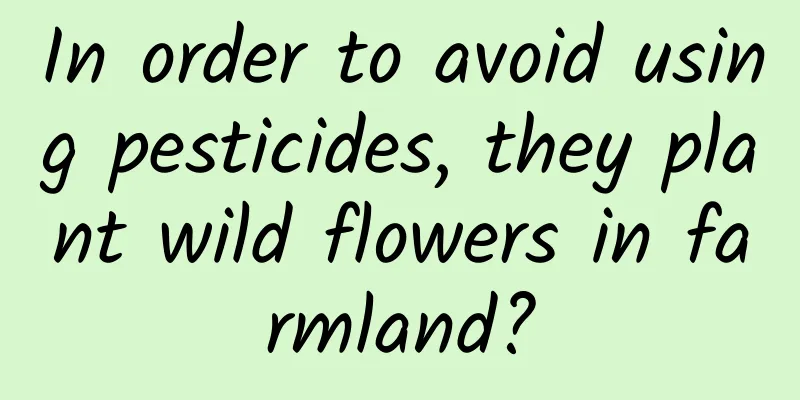In order to avoid using pesticides, they plant wild flowers in farmland?

|
Vegetables and fruits are an essential part of a healthy diet, but the pesticides that have to be used during the growth process always make people feel uneasy when washing and eating them. Is there a good way to avoid using pesticides and reduce pests? If you don't use pesticides, insects will grow I am worried that it is not safe to use pesticides According to the Food and Agriculture Organization of the United Nations (FAO), agricultural product losses due to pests and diseases account for about one-third of the total output each year . To reduce these crop losses, the simplest and most direct way is to use chemical pesticides, which are effective quickly. This makes pesticides seem to be an indispensable input for agricultural production - if pesticides are not used, pests will increase, and the yield and quality of fruits and vegetables will be seriously reduced, which cannot meet people's needs. Without the use of pesticides, agricultural output and quality will be seriously reduced|Pixabay However, many pesticides contain toxic chemicals . Once excessive residues are left and they are not properly cleaned, they may enter the human body through the food chain, causing potential damage. For farmers, long-term contact or excessive exposure to these pesticides can lead to poisoning symptoms, including headaches, eye pain, breathing difficulties, vomiting, chest tightness, rashes, etc. What is more serious is that the widespread and irrational use of pesticides will lead to pests developing resistance. This will further increase the use of pesticides and accidentally kill or interfere with other organisms in the ecological environment . One of the main causes of the colony collapse disorder that has occurred in many areas in recent years is the excessive use of pesticides. Colony Collapse Disorder When bees are exposed to pesticides, their central nervous system, memory system and the nerve areas that sense odors will be damaged, and the number and quality of their collections per day will decrease. This will disrupt the stability of bee colonies, and bee colonies in some areas will suddenly collapse - adult worker bees suddenly disappear outside the nest, leaving only a living queen bee, a large number of eggs and immature worker bees in the beehive; but they do not have obvious diseases. What's worse is that the number of bees has dropped sharply, but the demand for crops to rely on bees for pollination has not decreased, and has even increased. This will eventually trigger a " pollination crisis " and affect agricultural production. Bees are victims of pesticides, and the collapse of bee colonies will affect agricultural production|Pixabay In fact, the cultivation of crops is always accompanied by pest damage. Compared with history, in modern society with more advanced science and technology, fertilizers, pesticides and agricultural machinery have not reduced the problem of pests, but have become increasingly serious. Moreover, as part of the ecosystem, pests have complex interactions with other organisms. Instead of trying to completely eliminate pest populations, it is better to maintain a reasonable density of pest populations through ecological control measures, such as establishing "insect wildflower belts." Insect Wildflower Belt At the edges of farmland, orchards, vegetable fields and other agricultural land, strips or sheets of flowers are sometimes planted. These are insect wild flower belts , an important means of ecological pest control. Insect wildflower belts are ecological buffer zones formed by the alternation of multiple habitats. People usually plant different plants (such as Prunella vulgaris, Oxalis, Asteraceae, Leguminosae, Umbelliferae, etc.) in areas such as ridges and ditches, or even in certain farmlands. These plants and crops have different herbivorous insects, which can attract common natural enemies of pests (including ladybugs, lacewings, flower bugs, aphid flies, ground beetles, spiders, and parasitic wasps), providing them with a place to "eat, live, move, and live" (i.e., replace prey or host nutritional resources, habitat shelter, activities, and reproduction). Cornflowers attract ladybugs | Pixabay The natural enemies of these pests can be transferred to crops, effectively controlling the number of crop pests , thereby achieving the goal of effectively suppressing pests without using or using very little pesticides. This practice, called " ecological engineering pest control ," does not require the complete elimination of pests, but rather achieves a good ecological balance by controlling the appropriate pest population density and maintaining a complete food web in the community. But the benefits of insect wildflower strips to crops go beyond controlling pests. Wildflower strips can effectively control the invasion of weeds into farmland . Wildflower strips have rich plant species and grow fast, and can quickly form a vegetation cover layer. The width of insect wildflower strips is usually 2 to 4 meters, but the general weed seed propagation distance is only 1 meter. Therefore, insect wildflower strips are like a "Great Wall", effectively controlling the spread of weed seeds into farmland habitats. At the same time, the insect wildflower belt also provides a source of nectar and pollen without pesticide pollution for bees and other pollinating insects , which helps to improve the stability of the bee colony. These pollinating insects can also pollinate crops, increasing crop yields and quality. Therefore, the ecological function of the "wildflower belt" can be summarized as "providing beneficial insects with 'food, clothing, shelter, transportation and life'". In addition, the insect wildflower belt can also provide beautiful flower landscapes, bringing visual enjoyment. A belt of zinnias beside rice fields|Zhu Zengrong In the 1970s, European countries developed and implemented agricultural environmental management plans to address issues such as pollinator habitat destruction, biodiversity decline, and crop yield reduction. Planting insect wildflower belts is an important part of this plan, and after a long period of exploration, it has become increasingly mature. Today, China is also learning from international experience, discovering and selecting functional plants in native insect wildflower belts, developing and designing farmland ecological landscapes, and increasing biodiversity around crops . It is also using biodiversity and ecological engineering technologies to control crop pests while protecting pollinating insects. Other ecological pest control methods Insect wildflower strips are not the only ecological pest control method. They can be combined with other methods to create more diverse and complex ecological habitats . This integrated management approach helps improve pest control effectiveness, reduce dependence on chemical pesticides, and promote ecosystem health and sustainable agricultural development. Introducing natural enemies Insect wildflower strips provide habitats and food resources for predatory and parasitic natural enemies. Introducing beneficial natural enemies into farmland or gardens can not only directly control pest populations, but also attract natural enemies to insect wildflower strips and store them in the area after the crops are harvested, providing continuous pest control for subsequent crops. Mixed planting and intercropping Choose suitable crops for mixed planting or intercropping around or in insect wildflower belts. Different crops have different characteristics that can attract different types of pests, thus dispersing the pests from attacking a single crop. Crop rotation Insect wildflower strips can be used in conjunction with crop rotation systems in farmland. By regularly changing the planting location of crops , the accumulation and spread of specific pests can be reduced. When rotating crops, insect wildflower strips can be incorporated into the crop rotation system to provide continuous "food, clothing, shelter, transportation, and life" resources for beneficial insects such as natural enemies of pests. Agricultural conservation areas and ecological corridors Agricultural and natural enemy protection areas and ecological corridors should be set up around farmland or in adjacent areas. These areas include insect wildflower belts and other natural or artificial vegetation, which can provide insects with channels for habitat, reproduction and migration, and increase the connectivity of the ecosystem . Farmland is also part of nature|Pixabay In the past, we paid a huge ecological price for the application of broad-spectrum pesticides. Ecological pest management can not only reduce the overuse of broad-spectrum pesticides, protect the health and diversity of ecosystems, but also ensure that we can obtain safe and healthy agricultural products. When it comes to pest problems, the answers lie in nature. Author: Zhang Chao, Zhu Zengrong Editor: Mai Mai Title image source: Pixabay This article comes from GuokrNature (ID: GuokrNature) If you need to reprint, please contact [email protected] |
>>: "Quantifying" happiness: AI deciphers the dopamine code
Recommend
Too dangerous! A group of people were having a barbecue and suddenly it exploded! The reason was actually related to the ground
Oysters, beef cubes, pork belly Chicken legs, pal...
What is the situation under which people from other places stranded in Wuhan can apply for 3,000 yuan in government aid? What are the basic conditions for the subsidy?
Due to the city lockdown in Wuhan before the Spri...
From being popular to laying off employees, will the trend of shared charging finally stop?
"Unlike shared bikes, which have solved the p...
S7 also exploded: Samsung said that the Galaxy S7 series has no battery safety issues
After the Galaxy Note7 fire and explosion inciden...
How Apple is lowering the bar for medical research through software development
[[132519]] One of the biggest difficulties in med...
Winter mood "collapse"? Don't panic, these tips will help you see the sun again!
Every winter, many people often feel as if their ...
Rains at the turn of spring and summer bring forth all kinds of grains. What is the significance of “Gu Yu” to agricultural production?
April is halfway through, and the weather is gett...
Why do we need to analyze user behavior?
1. What is user behavior ? User behavior is compo...
"Short Video Secondary Editing Special Training 5.0" Master the short video secondary editing and mixed editing techniques with zero foundation
Course Contents: 01. Understand what is secondary...
"Heat shock" can also occur in winter, so be careful when taking a bath!
Audit expert: Peng Guoqiu Deputy Chief Physician,...
How to promote Xiaohongshu notes to become popular?
It is indeed difficult for a new account to becom...
WeChat vs. TikTok: Analysis report on 4 major categories!
In 2019, WeChat’s monthly active users reached 1....
Battery loss Apple decides on the frequency reduction for you, just get used to it
Every year after Apple releases a new iPhone at i...
What happened to the mystery of room-temperature superconductivity in those years?
Recently, South Korea's room-temperature supe...
The secret to reducing the cost of information flow video advertising by 50%, proven to be effective!
Short videos are surging, and various platforms h...









